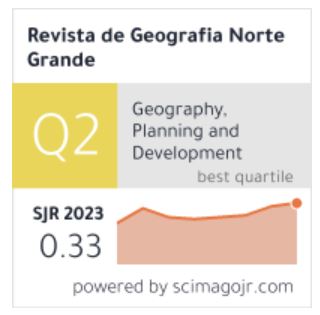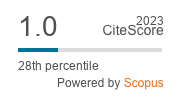Inequalities in access to water in rapidly growing urban cities in Latin America
the case of Arequipa, Peru
DOI:
https://doi.org/10.4067/S0718-34022021000300369Keywords:
water resources, urban areas, provision of water services, Arequipa, PeruAbstract
Cities in developing countries are going through an unprecedented process of urbanization that is reconfiguring their water supply systems. On the one hand, urbanization favors the expansion of formal water networks but on the other it also must resort to informal practices (pipe trucks, public pylons, etc.) especially in peripheral settlements. Using survey and secondary data for center and the periphery of Arequipa, Peru, we contrast the provision of water services by the two systems through the characterization of accessibility, availability, quality of service, price and preferred management model (public or private). Results indicate that networked supply systems in peripheral areas increase accessibility, but perform worse in terms of availability, quality of service and affordability. Although to a lesser extent, these problems are also present in the networked formal city regarding interruptions of service and prices. In peripheral areas informal systems remain precarious potentially generating unfavorable long-term effects. Hence, difficulties in access to reliable, safe and affordable water are observed in both contexts although the current public management system is preferred to private management.
Downloads
References
ABRAMO, P. La ciudad com-fusa: Mercado y producción de la estructura urbana en las grandes
metrópolis latinoamericanas. Eure, 2012, Vol. 38, Nº114, p. 35-69. http://doi:10.4067/S0250-
AHLERS, R., CLEAVER, F., RUSCA, M. y SCHWARTZ, K. Informal space in the urban waterscape:
Disaggregation and co-production of water services. Water Alternatives, 2014. Vol. 7, Nº1, p. 1-14.
ALLEN, A., DÁVILA, J.D. y HOFMANN, P. The peri-urban water poor: citizens or consumers? Environment
& Urbanization, 2006, Vol. 18, Nº2, p. 333-351. http://doi:10.1177/0956247806069608.
ALLEN, A., WALNYCKI, A. y VON BERTRAB, É. The Co-production of Water Justice in Latin American
Cities. En: A. ALLEN, L. GRIFFIN y C. JOHNSON (eds.), Environmental Justice and Urban Resilience
in the Global South. New York: Palgrave, 2017, p. 175-193. ISBN 978-1-137-47354-7.
ANDERSEN, A. O. Infrastructures of progress and dispossession: Collective responses to shrinking
water access among farmers in Arequipa , Peru. Focaal-Journal of Global and Historical Anthropology,
, Vol. 74, p. 28-41. http://doi:10.3167/fcl.2016.740103.
ANGUELETOU-MARTEAU, A. Informal water suppliers meeting water needs in the peri-urban territories
of Mumbai, an Indian perspective, 2009. (consulta: 17/09/2020). https://halshs.archives-ouvertes.
fr/file/index/docid/363464/filename/Angueletou_NT20-2008_.pdf
AZÓCAR, G., HENRÍQUEZ, C., VALENZUELA, C. y ROMERO, H. Tendencias sociodemográficas y
segregación socioespacial en los ángeles chile. Revista de Geografia Norte Grande, 2008, Nº41, p.
-128. http://doi:10.4067/s0718-34022008000300006.
BAIN, R.E.S., WRIGHT, J.A., CHRISTENSON, E. y BARTRAM, J.K. Rural: urban inequalities in post
targets and indicators for drinking-water. Science of the Total Environment, 2014, Vol. 490, p.
-513. http://doi:10.1016/j.scitotenv.2014.05.007.
BANANA, E., CHITEKWE-BITI, B. y WALNYCKI, A. Co-producing inclusive city-wide sanitation
strategies: lessons from Chinhoyi, Zimbabwe. IIED, 2015, Vol. 27, Nº1, p. 35-54. http://
doi:10.1177/0956247815569683.
BAYER, A.M., HUNTER, G. C., GILMAN, R.H., CORNEJO, J.G.,BERN, C. y LEVY, M.Z. Chagas Disease ,
Migration and Community Settlement Patterns in Arequipa , Peru. PLoS Negl Trop Dis, 2009, Vol.
, Nº12. http://doi:10.1371/journal.pntd.0000567.
BCR. Memoria 1985. Banco Central de Reserva del Perú. Lima 1985.
BERNAL, A., RIVAS, L. y PEÑA, P. Propuesta de un modelo de co-gestión para los Pequeños Abastos
Comunitarios de Agua en Colombia. Perfiles latinoamericanos, 2014, Vol. 22, Nº43, p. 159-184.
BIRKENHOLTZ, T. Full-cost recovery: Producing differentiated water collection practices and responses
to centralized water networks in Jaipur, India. Environment and Planning A, 2010, Vol. 42,
Nº9, p. 2238-2253. http://doi:10.1068/a4366.
Banco Mundial. Crecimiento de la población. Banco Mundial. (consulta: 27/03/20). https://datos.
bancomundial.org/indicador/SP.POP.GROW
BOTTON, S. y GOUVELLO, B. Water and sanitation in the Buenos Aires metropolitan region:
Fragmented markets, splintering effects? Geoforum, 2008, Vol. 39, Nº6, p. 1859-1870. http://
doi:10.1016/J.GEOFORUM.2008.08.003.
BUDDS, J. La demanda, evaluación y asignación del agua en el contexto de escasez: un análisis del
ciclo hidrosocial del valle del río La Ligua, Chile. Revista de geografía Norte Grande, 2012, Nº52, p.
-184. http://doi:10.4067/S0718-34022012000200010.
BUSTOS-CARA, R., SARTOR, A. y CIFUENTES, O. Modelos de gestión del recurso agua potable: el
caso de las cooperativas de servicios en pequeñas localidades de la Región Pampeana en Argentina.
Agua y Territorio, 2013, Nº1, p. 55. http://doi:10.17561/at.v1i1.1033.
CALDERON-COCKBURN, J. La insoportable levedad de la planificación urbana y lo legal informal
en el Perú. En CALDERON-COCKBURN, J. (ed.). La informalidad en Perú. Lima: Desco, 2017, p. 221-
CASTRO, M. y RIOFRÍO, G. La regularización de las barriadas: el caso de Villa El Salvador (Perú). En
Azusela, A.; François, T. (eds.). El acceso de los pobres al suelo urbano. México: Centro de estudios
mexicanos y centroamericanos, Universidad Nacional Autónoma de México, 1996, p. 45-88.
COHEN, B. Urbanization in developing countries: Current trends, future projections, and key challenges
for sustainability. Technology in Society, 2006, Vol. 28, Nº1-2, p. 63-80. http://doi:10.1016/j.
techsoc.2005.10.005.
COUTARD, O. Placing splintering urbanism: Introduction. Geoforum, 2008, Vol. 39, Nº6, p. 1815-
http://doi:10.1016/J.GEOFORUM.2008.10.008.
DEAN RANDALL, B., CLELAND, L., KUEHNE, C.S. y SHEER, D.P. Water supply planning simulation
model using mixed-integer linear programming. Journal of Water Resources Planning and Management,
, Vol. 123, Nº2, p. 116-124. http://doi:10.1061/(ASCE)0733-9496(1997)123:2(116).
EARTHSKY, 2019. Researchers investigate dramatic melt of glaciers in Peru. EarthSky. (Consulta:
/11/19). https://earthsky.org/earth/disappearing-peruvian-glaciers
GARDEN, T. Van. Collective organization and action in squatter settlements in Arequipa, Perú. En:
F. SCHUURMAN y T. Van NAERSSEN (eds.), Urban Social Movements in the Third World. First Edit.
New York: Routledge, 1989, p. 27-44.
GRAHAM, S. y MARVIN, S. Splintering Urbanism: Networked Infrastructures, Technological Mobilities,
and the Urban Condition (review). New York: Taylor & Francis, 2001. ISBN 0203452208.
JOURAVLEV, A. Los servicios de agua potable y saneamiento en el umbral del siglo XXI. Santiago
de Chile: CEPAL, 2004. ISBN 9213222211.
KLIEN, M. Corporatization and the Behavior of Public Firms: How Shifting Control Rights Affects
Political Interference in Water Prices. Rev Ind Organ, 2014, Vol. 44, p. 393-422. http://doi:10.1007/
s11151-013-9401-0.
KOOY, M. & BAKKER, K. Splintered networks: The colonial and contemporary waters of Jakarta.
Geoforum, 2008, Vol. 39, Nº6, p. 1843-1858. http://doi:10.1016/J.GEOFORUM.2008.07.012.
LIDDLE, E.S., MAGER, S.M. & NEL, E.L. The importance of community-based informal water supply
systems in the developing world and the need for formal sector support. Geographical Journal,
, Vol. 182, Nº1, p. 85-96. http://doi:10.1111/geoj.12117.
MATSINHE, N.P., JUÍZO, D., MACHEVE, B. y SANTOS, C. Regulation of formal and informal water
service providers in peri-urban areas of Maputo, Mozambique. Physics and Chemistry of the Earth,
, Vol. 33, Nº8-13, p. 841-849. http://doi:10.1016/J.PCE.2008.06.046.
MCMILLAN, R., SPRONK, S. y CASWELL, C. Popular participation, equity, and co-production of
water and sanitation services in Caracas, Venezuela. Water International, 2014, Vol. 39, Nº2, p.
-215. http://doi:10.1080/02508060.2014.886844.
MEHTA, V.K., GOSWAMI, R., KEMP-BENEDICT, E., MUDDU, S. y MALGHAN, D. Metabolic Urbanism
and Environmental Justice: The Water Conundrum in Bangalore, India. Enviromental Justice, 2014,
Vol. 7. http://doi:10.1089/env.2014.0021.
MITLIN, D. With and beyond the state-co-production as a route to political infl uence, power and
transformation for grassroots organizations. Environment & Urbanization, 2008, Vol. 20, Nº2, p.
-360. http://doi:10.1177/0956247808096117.
MITLIN, D., BEARD, V.A., SATTERTHWAITE, D. & DU, J. Unaffordable and Undrinkable: Rethinking
Urban Water Access in the Global South. World Resources Institute, 2019.
MORETTO, L., FALDI, G., RANZATO, M., ROSATI, F.N.,ILITO BOOZI, J.P. y TELLER, J. Challenges of
water and sanitation service co-production in the global South. Environment and Urbanization,
, Vol. 30, Nº2, p. 425-443. http://doi:10.1177/0956247818790652.
ONU. Agua Potable y Saneamiento Ambiental en América Latina. Santiago; Naciones Unidas, 1983.
ONU. Las ciudades seguirán creciendo, sobre todo en los países en desarrollo. ONU, 2018. (Consulta:
/03/2020). https://www.un.org/development/desa/es/news/population/2018-world-urbanization-
prospects.html
OPRYSZKO, M.C., HUANG, H., SODERLUND, K. y SCHWAB, K.J. Data gaps in evidence-based research
on small water enterprises in developing countries. Journal of Water and Health, 2009, Vol.
, Nº4, p. 609-622. http://doi:10.2166/wh.2009.213.
PFLIEGER, G. y MATTHIEUSSENT, S. Water and power in Santiago de Chile: Socio-spatial segregation
through network integration. Geoforum, 2008, Vol. 39, Nº6, p. 1907-1921. http://doi:10.1016/j.
geoforum.2008.09.001.
PINEDA-ZUMARAN, J. Learning and Knowledge Generation in Local Decision Making in the
South. Journal of Planning Education and Research, 2016, Vol. 36, Nº1, p. 60-75. http://
doi:10.1177/0739456X15601186.
RIVERA, P., NAVARRO, K. & CHÁVEZ, R. Cobertura socio-espacial y consumo doméstico de agua en
la ciudad de Tijuana: ¿es de utilidad la misma gestión para diferentes usuarios? Agua y Territorio,
, Nº9, p. 34. http://doi:10.17561/at.v0i9.3475.
RUSK, D. Cities without suburbs. Woodrow Wilson Center Press, 1993. (Consulta: 29/10/19). https://
scholar.google.es/scholar?hl=es&as_sdt=0%2C5&q=cities+without+suburbs+david+rusk&btnG=
SAURI, D. y DEL MORAL, L. Recent developments in Spanish water policy. Alternatives and conflicts
at the end of the hydraulic age. Geoforum, 2001, Vol. 32, Nº3, p. 351-362. http://doi:10.1016/
S0016-7185(00)00048-8.
SEDAPAR. MEMORIA ANUAL 2017. Arequipa: SEDAPAR, 2017.
UNICEF y WHO. Progress on household drinking water, sanitation and hygiene 2000-2017. New
York: UNICEF and WHO, 2019.
VILCHIS-MATA, I., GARROCHO-RANGEL, C.F. & DÍAZ-DELGADO, C. Modelo dinámico adaptativo
para la toma de decisiones sostenibles en el ciclo hidrosocial urbano en México. Revista de Geografia
Norte Grande, 2018, Nº71, p. 59-90. http://doi:10.4067/s0718-34022018000300059.
WALNYCKI, A. Contesting and Co-Producing the Right to Water in Peri-Urban Cochabamba. En
Bell, S., Allen, A., Hofman, P. & The, T. (eds.). Urban Water Trajectories. London: Future City 2017,
p. 133-147.
WHO/UNICEF. Progress on Drinking Water and Sanitation. Luxemburg: WHO/UNICEF, 2014.
ZAPANA, L. Respuestas a la crisis hídrica en zonas agrícolas y urbanas: Caso de estudio “Proyecto
de Irrigación Majes Siguas I” Arequipa – Perú. Agua y Territorio, 2018, Nº12, p. 145-156. http://
doi:10.17561/at.12.3532.
Downloads
Published
How to Cite
Issue
Section
License
Copyright (c) 2021 Revista de Geografía Norte Grande

This work is licensed under a Creative Commons Attribution 4.0 International License.






